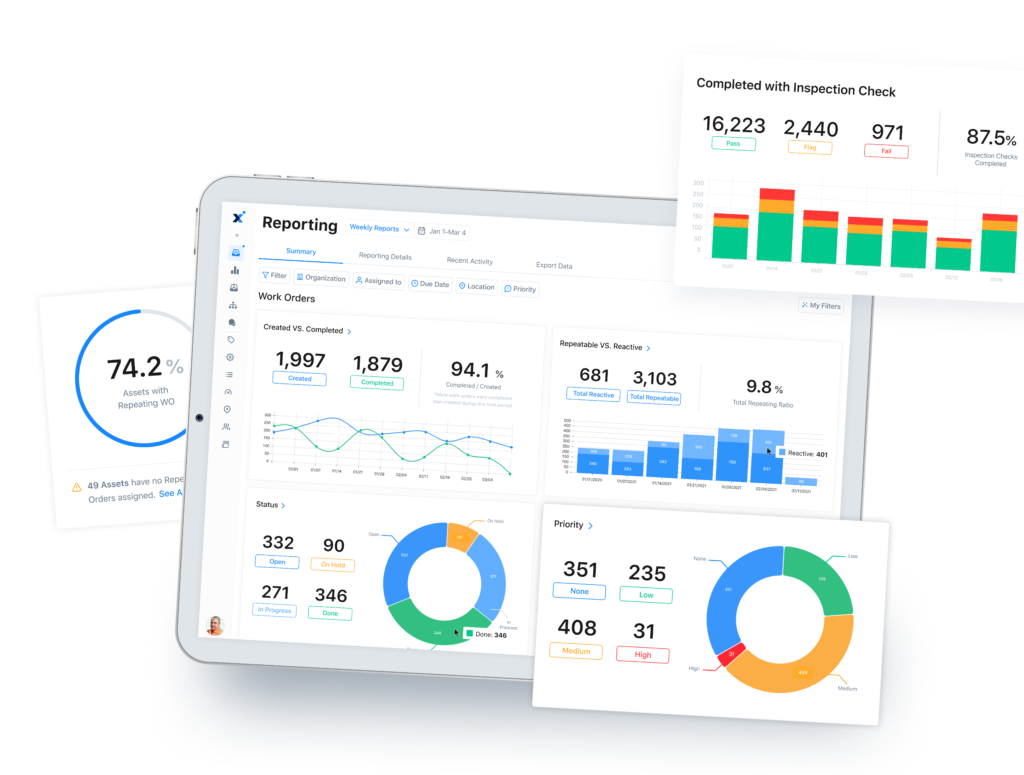
A Unified Namespace system assigns a unique identifier to each device, system, and piece of equipment within a manufacturing facility.
This identifier, known as a Uniform Resource Identifier (URI), allows for easy communication and integration between these different systems and devices.
Key performance indicators (KPIs) are measurable benchmarks to evaluate our ongoing workflows and progress, personally and professionally. For example, maintenance KPIs help us know where we’re gaining momentum, where we’re falling behind, and where we’re standing still.
UNS and Improved KPIs
UNS can improve KPI tracking and analysis in manufacturing maintenance by automating processes and enabling real-time data collection and analysis. With the right machine-learning algorithms, using a UNS combined with a robust CMMS can help identify trends and patterns in maintenance performance.
Specific KPIs can indicate where to uptime, mean time to repair, and maintenance costs. In addition, integrating a UNS with maintenance processes can improve efficiency and effectiveness, resulting in improved performance on these KPIs.

Key Performance Indicators
Overall Equipment Effectiveness (OEE)
OEE is a manufacturing standard used to measure the productivity of facilities, processes, and equipment. OEE indicates how efficiently companies manage production by calculating asset availability, asset performance, and product quality.
To calculate OEE:
OEE = Availability * Performance * Quality, where:
Availability = Run Time / Planned Production Time
Performance = Planned Production Time – Stop Time
Quality = Good Count / Total Count
Successful manufacturing plants consistently monitor several critical equipment parameters that contribute to operational performance. Overall Equipment Effectiveness (OEE) is one metric that helps companies identify the percentage of productive manufacturing time.
For example, if a machine is experiencing frequent downtimes due to maintenance issues, the UNS could be used to track the frequency and duration of these downtimes and the root cause of the issues. This data could then be used to improve the maintenance process and increase the availability of the machine, resulting in an improvement in OEE.
“When organizations implement new industrial IoT solutions, you need a unified namespace—a software solution that acts as a centralized repository of data . . . The solution allows users to collect data from various sources, add context so there’s meaning to it, and transform it to a format that other systems can understand.”
Smart Industry
Planned Maintenance Percentage (PMP)
PMP refers to the percentage of overall maintenance time that goes into planned maintenance activities. It’s usually measured against the total amount of time spent on maintenance in a given time period.
To calculate PMP:
PMP = (Total Planned Maintenance Hours / Total Maintenance Hours) * 100
PMP is a maintenance metric that illustrates the number of planned maintenance activities compared to all organizational maintenance activities. It’s a valuable key performance indicator to track the effectiveness of PM programs.
Maintenance managers can calculate PMP for weekly, monthly, or yearly intervals. When establishing maintenance programs, leadership must determine which PM activities should be accomplished and how often. It’s essential to find the perfect balance between preventive and corrective maintenance work orders—experts recommend an ideal 80:20 ratio.
A CMMS can help improve PMP by providing a tool for scheduling and tracking planned maintenance activities. This can help ensure maintenance is performed regularly and on schedule, reducing the risk of unplanned downtime.
Mean Time Between Failure (MTBF)
MTBF is a maintenance metric that measures the standard amount of time between expected equipment failures for an asset performing under normal operational usage. Maintenance professionals use MTBF to inform equipment design, optimize preventive maintenance scheduling, and maintain reliability for their most essential pieces of equipment.
Mean Time Between Failure (MTBF) is the “uptime” between two failure states of a repairable system.
MTBF is only used in conjunction with repairable assets.
MTBF = Total Uptime of Repairable Asset / Number of Failures of Asset within set time period
Thus, maintenance managers calculate the metric assuming that tangible asset failure is inevitable—the question isn’t if the machinery will break down, but when? The higher the MTBF, the more likely the asset will operate uninterrupted for an extended period.
The precise definition of Mean Time Between Failure is contingent on what gets categorized as a “failure.” Most maintenance departments consider equipment failures to be completely out-of-service states of operation. Therefore, minor malfunctions are not classified as failures.
A unified namespace system can improve MTBF by enabling quicker and more accurate identification of equipment. This can be especially important when it comes to proactive maintenance, which involves identifying equipment at risk of failure and performing maintenance to prevent those failures.
For example, suppose a specific type of equipment has a higher failure rate than others. In that case, a unified namespace system can help identify all of the equipment of that type and prioritize maintenance for those assets. This can help reduce the frequency of equipment failures and improve MTBF.
Mean Time to Repair (MTTR)
MTTR refers to the average time maintenance teams spend diagnosing, fixing, and recovering failed pieces of equipment. The KPI is a baseline that maintenance departments use to improve asset efficiency, minimize unplanned downtimes, boost bottom lines, and assess equipment value. MTTR provides a useful productivity benchmark for organizations seeking to reduce prolonged repair times and associated expenses.
To calculate MTTR:
MTTR = Total Maintenance TIme / Number of Repairs
For example, if an organization spends 50 hours total on unplanned maintenance for an asset that broke down eight times in one year, the asset’s MTTR is 6.25 hours. The calculation would be:
50 hours / 8 = 6.25
Notably, MTTR doesn’t depend on an asset’s uptime. It only factors in how long each unplanned stoppage lasts. The MTTR formula assumes all maintenance tasks are performed sequentially and by well-trained maintenance personnel.
Maintenance experts recommend striving for an ideal MTTR below 5 hours. However, the metric can vary substantially based on asset type and importance. Savvy department leaders routinely monitor MTTR for both individual pieces of equipment and the organization.
The metric provides insights into maintenance scheduling, replacement parts purchases, and maintenance task completion. Ultimately, delving deeper into “the whys” behind extensive MTTR metrics helps maintenance teams increase uptime, enhance efficiency, and decrease unnecessary costs.
A unified namespace system can help reduce the risk of equipment failures due to human error, which can help improve MTTR. For example, if different departments or teams use different naming conventions for the same equipment, it can be challenging to accurately track and identify that equipment.

Industry 4.0 and United Namespace
These days, with IIot and the global marketplace, manufacturing maintenance spaces use technology to improve and optimize maintenance processes. This can include using industrial data analytics to identify trends and predict equipment failures, implementing advanced maintenance planning and scheduling systems, and integrating maintenance processes with other systems and processes within the manufacturing facility.
The Unified Namespace system is an essential component of digital transformation, the “internet of things,” and manufacturing maintenance. It enables the integration and communication of various systems and devices within the manufacturing facility. In addition, this can facilitate the exchange of data between different systems and devices, allowing for the automation of many processes and the optimization of maintenance activities.
For example, the UNS can integrate a Computerized Maintenance Management System (CMMS) with other systems and devices within the manufacturing facility. This can allow for an interactive and automatic collection and analysis of maintenance data, enabling more effective maintenance planning and scheduling.
CMMS, UNS, and Manufacturing Maintenance
Of all the different use cases, one of the main ways a CMMS helps with UNS and manufacturing maintenance is by providing a central database for storing and organizing maintenance-related data.
The UNS can identify and retrieve the data for specific tasks or processes. In other words, the data lake is a central repository for storing and managing this data. Walker Reynolds explains that UNS can be the organization data hub based on ISA-95‘s “Hierarchical Equipment Model.”
This includes things like maintenance schedules, equipment histories, and repair records. In addition, you can integrate the CMMS with the UNS to allow for seamless data between different systems and devices within the manufacturing facility.

Integrate Your UNS with MaintainX
Use the MaintainX API to connect with, retrieve, and manage data associated with Work Orders, Work Requests, Assets, and more. An API (Application Programming Interface) is a set of rules for systems to communicate with each other. It allows integration and data exchange between systems. An API with a UNS can facilitate the integration and communication of systems and devices in a manufacturing facility. For example, an API could allow an MES to access and retrieve data from a machine monitoring system using the unique identifiers assigned by the UNS. The API and UNS enable data exchange and process automation in a manufacturing facility.
Likewise, ERP systems (Enterprise Resource Planning) are software platforms that allow companies to manage and integrate various business processes, such as accounting, supply chain management, and production planning, into a single system. With MaintainX, you can integrate your UNS across your company to provide a single data source that all departments can access.
In addition to providing a central database for storing and organizing maintenance data, a CMMS includes several other features that can help with manufacturing maintenance. These include work order management, inventory control, and asset management. Using a CMMS, a manufacturing company can more effectively plan and manage maintenance activities, improving efficiency and productivity.
FAQs

Caroline Eisner is a writer and editor with experience across the profit and nonprofit sectors, government, education, and financial organizations. She has held leadership positions in K16 institutions and has led large-scale digital projects, interactive websites, and a business writing consultancy.


.jpeg)


.jpeg)














